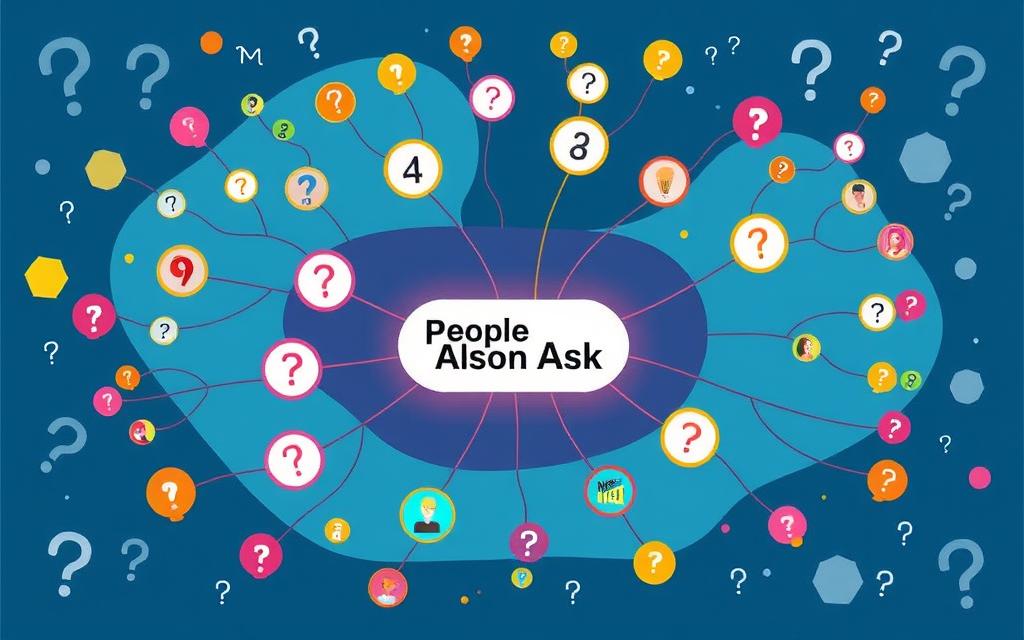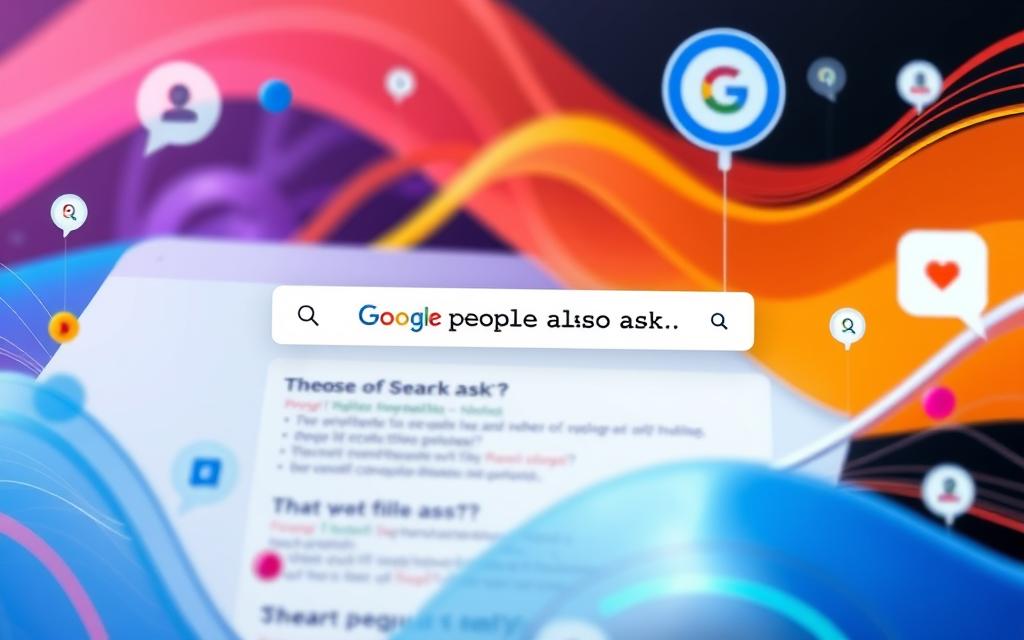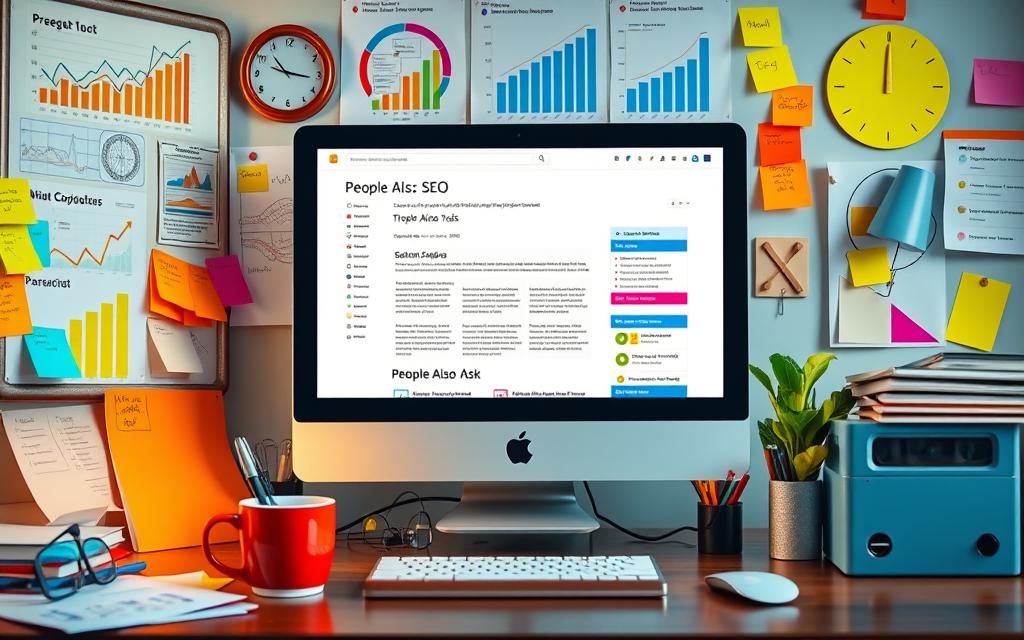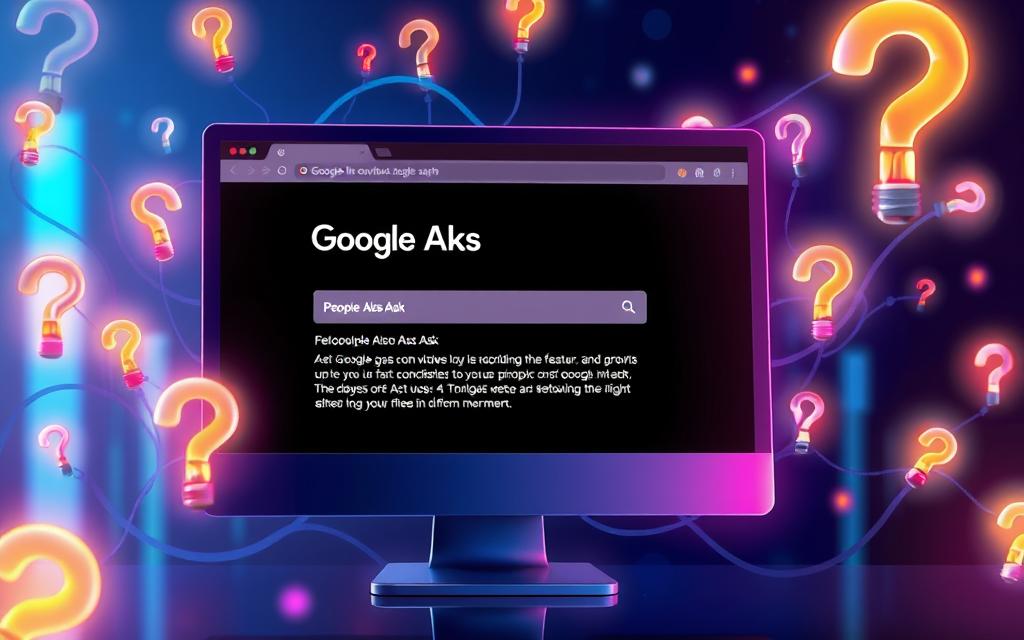The “People Also Ask” (PAA) feature is a key part of Google’s search results. It shows users more questions related to their search. These questions are in a box and can be clicked to see short answers that link to web pages.
PAA helps users find quick, relevant info. It also encourages them to explore more related topics. Being in the PAA section can help businesses and content creators get more visibility, drive traffic, and build a niche.
This article will dive into how PAA works, its benefits, and how to optimize content for it. By understanding PAA and using the right strategies, you can improve your Google search presence. This can help you reach more people.
Key Takeaways
- The “People Also Ask” (PAA) feature is a dynamic component of Google’s search results that displays additional related questions to users.
- Appearing in the PAA box can increase visibility, drive traffic, and establish your website as a trusted source of information.
- Optimizing content for PAA involves creating concise answers, using a question-and-answer format, and targeting long-tail keywords.
- Analyzing the “People Also Ask” tree can provide valuable insights into related queries and user search intent.
- Integrating PAA optimization into your SEO strategy can help you capture a wider audience and compete for featured snippets.
What is Google “People Also Ask”?
The Google “People Also Ask” (PAA) feature is a key part of search engine results pages. It shows users a list of related questions based on their search. This makes it easy to find more information on topics they’re interested in.
Explaining the PAA Feature and Its Purpose
The PAA box is found near the top of search results, just after the first organic listing. It offers a list of questions related to the user’s search. This helps users find more specific and useful information.
Google’s advanced algorithms analyze search trends and user intent. They use this to create a list of questions that are likely to be helpful.
Understanding How PAA Enhances User Experience
The “People Also Ask” feature is great for users who are unsure about their search terms. It presents more questions, helping users explore new topics. This leads to more detailed and satisfying search results.
This feature makes searching more intuitive and engaging. It helps users find the information they need more easily.

| Key Statistic | Value |
|---|---|
| PAA Appearance Rate | 51.85% of all searches |
| PAA Content Types | Blogs, YouTube videos, FAQs |
| PAA Visibility Increase | 10 times more likely to be clicked than 10th result |
The Google “People Also Ask” feature is a valuable tool for users. It provides a list of related questions, making searching more effective. By analyzing search trends and user intent, the PAA box helps users find more precise information. This makes it a key part of modern search engine optimization strategies.
How Does Google’s PAA Algorithm Work?
The “People Also Ask” (PAA) feature on Google makes searching easier. It shows related questions based on what you first search for. This is thanks to Google’s smart algorithms, which use machine learning and natural language processing.
The Role of Machine Learning and Natural Language Processing
Google’s PAA algorithm uses machine learning to spot search patterns. It also understands the language of searches. This helps it guess what questions you might have next.
This smart method gives you a list of questions you might want to ask. These questions are shown in a way that makes you want to explore more. The answers are short and to the point, meeting your needs and interests.
| Key Factors Influencing Google’s PAA Algorithm | Impact on PAA Results |
|---|---|
| Search History and Trends | Identifying common questions and user search patterns |
| User Intent and Behavior | Predicting related queries based on user interactions |
| Natural Language Processing | Understanding the meaning and context of search queries |
| Machine Learning Algorithms | Continuously improving the accuracy and relevance of PAA results |
Thanks to machine learning and natural language processing, Google’s PAA makes searching better. It also helps businesses show up more online.

Benefits of Ranking in the PAA Box
Getting into Google’s “People Also Ask” (PAA) feature is a big goal for SEO. Being in the PAA box brings many benefits. These include increased visibility, establishing authority, and winning your audience’s trust.
Increased Visibility and Click-Through Rates
The PAA box shows up high on search pages, often before most organic results. This spot means your content gets more visibility. It’s more likely for users to see and click on your site. In fact, PAA boxes show up in 78% of desktop and 77% of mobile search results.
Establishing Authority and Building Trust
Being in the PAA box makes your site seem like a trusted source. By answering users’ questions quickly and accurately, you show you know your stuff. This boosts your site’s credibility and can lead to more engagement and better SEO.
Working to rank in the PAA box is a smart move. It can greatly improve your visibility, click-through rates, and make your site a go-to authority. By using these strategies, you can grow your online presence and achieve more success.

Identifying Common Questions and User Intent
To optimize for Google’s “People Also Ask” (PAA) section, you need a smart content strategy. Start by finding out what questions people often ask in your field. Use tools like SEMrush, Ahrefs, and AnswerThePublic to find these questions in PAA boxes.
Look at how these questions are structured and phrased. This helps you match your content to what users are looking for. Try different keywords in the search bar to find more specific questions. Knowing what users really want is key to making great content for PAA.
- Over 80% of English searches display PAA results, usually within the first few search results.
- Google’s research shows it takes about eight searches for a user to complete a task, with PAA results helping.
- People Also Ask results help Google understand user queries better, making it easier to find what you need.
Using People Also Ask data can help improve your website’s ranking. It helps match your content to what users are looking for. Services like AlsoAsked give you free access to PAA data, helping you stay ahead in search trends.
| Benefit | Impact |
|---|---|
| Increased Visibility | Over 35% of clicks on search engine result pages (SERPs) go to featured snippets, such as People Also Ask (PAA) boxes. |
| Improved User Engagement | Only 27% of people thoroughly consume content online, indicating that most users tend to skim for important details. |
| Stronger Brand Authority | Content that appears in featured snippets like PAA can significantly increase visibility, organic traffic, and credibility, providing a competitive advantage for brands. |
By finding common questions and understanding what users want, you can make content that meets their needs. This boosts your chances of showing up in the PAA section.

Creating High-Quality, Concise Answers
When it comes to Google’s “People Also Ask” (PAA) feature, making high-quality, concise answers is crucial. These short responses, usually 40-60 words, give users quick and helpful answers. The aim is to answer the question directly and then provide more details later.
To make effective PAA answers, keep these tips in mind:
- Understand what the user is looking for and the main question.
- Give a clear, step-by-step answer or a definitive response.
- Add more context and details in the following paragraphs.
- Use simple language that’s easy to understand and avoids jargon.
- Make sure your answers are correct, up-to-date, and match the search query.
By using this method, you help Google see your content as valuable for the “People Also Ask” feature. This can improve your visibility, boost click-through rates, and show your expertise on the topic.
| PAA Optimization Strategies | Key Considerations |
|---|---|
| Concise Answers | Keep responses within 40-60 words to address the query directly. |
| Useful Context | Expand on the answer with additional details and information in the body of your content. |
| Targeted Keywords | Incorporate relevant keywords and phrases that align with the user’s search intent. |
| Structured Content | Use a question-and-answer format to make it easy for Google to identify and extract your responses. |

By focusing on writing high-quality, concise answers for the “People Also Ask” feature, you can make your content more visible, increase engagement, and show your expertise to both users and search engines.
Structuring Content for PAA Optimization
To get your content in the “People Also Ask” (PAA) section on Google, use a question-and-answer format. This makes it easy for Google to find and show your content in the PAA section. It brings more visitors to your site.
Using a Question-and-Answer Format
First, find out what questions your audience is asking. Tools like Google Keyword Planner and SEMrush can help. They show you what questions people are searching for.
After finding these questions, write clear answers. Use short paragraphs and bullet points to make it easy to read.
Use H2 and H3 headers to organize your content. This helps Google understand your content better. It makes it more likely to show up in the PAA box.
Give direct and to-the-point answers to questions. This format not only helps you show up in the PAA section. It also makes your content more useful to users by giving them quick answers.
Optimizing for featured snippets can also help. By giving short, direct answers, you might get your content to be a featured snippet. Featured snippets often appear in the PAA box.
Optimizing your content for PAA and featured snippets is a smart move. It can make your site more visible and attract more visitors. By answering questions and providing useful information, you can become a trusted source in your field. This improves your search engine ranking.
Targeting Long-Tail Keywords
Optimizing your content for Google’s “People Also Ask” (PAA) feature involves targeting long-tail keywords. These are specific search terms that show what users really want. They might not get as many searches as shorter terms, but they’re great for bringing in the right visitors and boosting sales.
Incorporating Related Phrases and Variations
To find the right long-tail keywords for PAA, you need to do some research. Use tools like SEMrush, Ahrefs, and AnswerThePublic to find relevant keywords and phrases. Adding these to your content, especially in Q&A sections, can help you show up in the PAA box and reach your target audience.
Long-tail keywords have many benefits:
- They have less competition, making it easier to rank.
- They show a user’s intent to buy, leading to more sales.
- They help you show your expertise and become an authority in your field.
Remember, PAA questions often use long-tail keywords. By matching your content to these specific questions, you can get more visibility, attract better traffic, and boost your SEO.
Providing Comprehensive Topic Coverage
Ranking in Google’s “People Also Ask” (PAA) feature requires comprehensive topic coverage. Google’s algorithm looks for content that fully answers a user’s query. By covering all sides of a topic, you boost your chances of being in the PAA box. This drives more organic traffic to your site.
To succeed, break your content into easy-to-digest sections. Each section should explore a different part of the subject. This makes the info easy to understand and shows your expertise. Make sure your content is structured like a Q&A, answering common user questions.
- Do thorough keyword research to find all the questions and subtopics related to your main topic.
- Write detailed, informative answers to these questions in a clear and engaging way.
- Link your content together so users can easily move from one section to another. This gives a full view of the subject.
- Use schema markup to help Google understand your content’s structure. This increases your chances of being in the PAA box.
By offering a deep dive into a subject, you show your expertise. This makes it more likely for Google to feature your content in the “People Also Ask” section. This can lead to more visibility, higher click-through rates, and better brand credibility.
Success in the PAA game comes from creating content that answers your audience’s questions. Focus on providing value and making your site a trusted resource on the topic.
google people also ask
Google’s “People Also Ask” (PAA) feature is a key part of search results. It gives users more info on their search topics. This box shows relevant questions and answers, making it easier to find what you need.
By understanding PAA and how to optimize for it, you can improve your website. This can make your site more visible, authoritative, and user-friendly.
Leveraging PAA for Increased Exposure
The PAA feature has many benefits for businesses. It can make your site more visible on search engine results pages (SERPs). In fact, the PAA box gets clicked 3% of the time.
By optimizing your content for the PAA box, you can grab the attention of users. They’re looking for info on your products or services.
Establishing Authority and Building Trust
Being in the PAA box can also make your brand more authoritative. It shows your site is a trusted source for answers. This builds credibility and trust with your audience.
This can improve your brand’s reputation, engagement, and conversions. It’s a win-win for your business.
Uncovering Valuable Insights
Looking at PAA questions can give you insights for your content. You can see what topics and questions are important to your audience. This helps you create content that meets their needs.
It also guides your keyword research. You can find long-tail keywords that might trigger the PAA feature.
To make the most of Google’s “People Also Ask” feature, optimize your content. Create short, informative answers and use relevant keywords. Schema markup can also help you appear in the PAA box. This boosts your site’s visibility, authority, and engagement.
Analyzing the PAA Tree for Insights
The “People Also Ask” (PAA) feature on Google gives us valuable insights. It shows us related queries and what users are looking for. By looking at the PAA tree, we can understand how the original question connects to other questions. This helps us make our content better match what users want to find.
Understanding Related Queries and User Search Intent
The PAA box shows us what users are curious about. Google picks these questions because they’re relevant and popular. By studying the PAA tree, we can find:
- Common questions and concerns that users have about the topic
- Variations of the original query and related keywords
- Subtopics or subtasks that users are trying to accomplish
- The overall user search intent, whether it’s informational, navigational, or transactional
This knowledge helps us make content that meets our audience’s needs. It also helps us find new keywords to rank for. This way, we can make our pages more relevant and useful.
By analyzing the “people also ask” tree and understanding related queries and user search intent, we can improve our content strategy. This can boost our SEO, making our site more visible and trustworthy. It helps us attract more visitors and establish our brand as an authority in our field.
Optimizing for Page Speed and Mobile Usability
Page speed and mobile usability are key for the Google “People Also Ask” (PAA) feature. To boost your chances of showing up in the PAA box, focus on making your site fast and mobile-friendly.
Google says your mobile site should load in under 3 seconds. The time to first byte should be under 1.3 seconds. Also, your mobile page should be under 500 KB, and it should have fewer than 50 pieces of content.
By making your site fast and mobile-friendly, you improve the user experience. This can help your content show up in the PAA box. In 2018, user-centric performance metrics improved by 15% to 20% for the slowest one-third of traffic, and more than 95% of countries had improved speeds across the whole web ecosystem. This led to a 20% drop in abandonment rate for Search-initiated navigations.
Stay ahead by regularly checking your site’s speed with PageSpeed Insights. This ensures your content is fast, mobile-friendly, and ready for the Google “People Also Ask” feature.
| Metric | Recommended Value |
|---|---|
| Time to First Byte (TTFB) | Under 1.3 seconds |
| Page Load Time | Under 3 seconds |
| Total Page Size | Less than 500 KB |
| Number of Resources | Fewer than 50 |
Tools for Analyzing and Optimizing PAA
Getting the right tools for Google “People Also Ask” (PAA) can really boost your SEO. Many tools help you analyze and optimize your content for this important spot.
AlsoAsked lets you find long-tail keywords and understand what users are searching for. It helps you see the questions your audience has and tailor your content to answer them.
Botster scrapes the PAA section, giving you data on questions and answers for your keywords. This info is key to creating answers that engage your readers.
Frase and KeywordsPeopleUse are great for a deeper dive. They help you explore related queries and optimize for featured snippets and the PAA box.
SEO Minion also scrapes the PAA section, offering insights into displayed questions and answers. Using these tools can give you an edge in SEO and help you show up in the PAA section.
Pricing for these tools varies. Positional starts at $299 a month, and AlsoAsked is $12 a month. But, KeywordsPeopleUse has free features, making it affordable for all businesses.
By using these tools to analyze and optimize your content for Google “People Also Ask,” you can increase your online presence. You’ll also establish your authority and attract more relevant traffic to your site.
Programmatic SEO and API Integration
Using programmatic SEO and API integration can boost your Google “People Also Ask” (PAA) optimization. Tools like AlsoAsked provide a sync/async API with webhook support. This makes it easy to work with live PAA data.
Automating Content Optimization and Keyword Research
APIs help automate content optimization and keyword research. This saves time and resources. Use PAA data to find trending topics and “zero volume” keywords. This improves your SEO strategy.
- Programmatically monitor and update content to address new PAA questions as they emerge
- Automate keyword research by analyzing the related queries surfaced in the PAA boxes
- Integrate live PAA data into your tools and web applications for real-time optimization
As search trends change, using programmatic SEO and API integration keeps you ahead. Automating tasks like content optimization and keyword research lets you work more efficiently. This keeps you competitive in the Google “People Also Ask” world.
| Benefit | Description |
|---|---|
| Increased Efficiency | Automate content optimization and keyword research tasks to save time and resources |
| Improved Agility | Quickly adapt to changes in PAA questions and trends by using programmatic tools |
| Competitive Advantage | Stay ahead of the competition by leveraging real-time PAA data for better optimization |
Uncovering “Zero Volume” Keywords
In the world of SEO, many focus on high-volume keywords. But “zero volume” keywords are often overlooked. These long-tail search terms may not get a lot of searches. Yet, they can be very valuable for your content strategy.
The “People Also Ask” feature in Google’s search results is a treasure trove for these keywords. Tools like AlsoAsked show the specific queries users are searching for. Even if these searches are not common.
- Targeting zero volume keywords can help you create content that addresses specific user search intent. This can improve your chances of ranking higher in Google’s search engine results pages (SERPs).
- By tapping into niche queries that your competitors may overlook, you can drive more targeted traffic to your site. This helps establish your authority on the topic.
- Industry experts have reported successful outcomes by targeting zero-volume keywords. They’ve seen over 10K traffic and high-quality leads.
Uncovering zero volume keywords requires research, creativity, and understanding your target audience. Tools like Google Autocomplete, Google Search Console, and customer interviews can give you insights. They show the specific queries your audience is searching for.
| Keyword | Search Volume | Potential Traffic |
|---|---|---|
| best pizza in new york | 1,000 | 3,000 |
| how to make homemade pizza | 500 | 2,000 |
| what is the origin of pizza | 0 | 500 |
By focusing on these “zero volume” keywords, you can find new ways to reach your audience. This can lead to more meaningful engagement with your content. So, don’t overlook the power of these hidden gems. They could be the key to your next SEO breakthrough.
Streamlining Keyword Research with PAA
Using the “People Also Ask” (PAA) feature can change how you do keyword research. Tools like AlsoAsked let you export images and search in bulk. This helps you find important questions and answers fast. The Deep Search feature can give you up to 150 questions at once, which is super helpful for coming up with new content ideas and keywords.
Saving Time and Increasing Efficiency
These tools make your research faster and more efficient. You can spend more time making great content and get a better chance to show up in the PAA section. The streamlining keyword research with google “people also ask” method saves you time and boosts your efficiency. You get a lot of useful info with just a few clicks.
The saving time and increasing efficiency with google “people also ask” method helps you find long-tail keywords and understand what users are looking for. This way, you can make your content better and rank higher in the PAA box. This can lead to more people seeing your content, more clicks, and better search engine rankings.
| Feature | Benefit |
|---|---|
| Image Exports | Quickly visualize relevant questions and answers |
| Bulk Searches | Efficiently identify a large number of related queries |
| Deep Search | Uncover an average of 150 questions per query |
By using the streamlining keyword research with google “people also ask” and saving time and increasing efficiency with google “people also ask” strategies, you can open up many opportunities for your content. This can greatly improve your search engine performance.
Conclusion
Optimizing your content for Google’s “People Also Ask” (PAA) feature is crucial for your SEO strategy. It boosts your visibility and click-through rates. It also makes your brand a leader in your field.
By using PAA, you can reach more people and improve your search engine ranking. Focus on answering common questions with clear and concise answers. Use a question-and-answer format for your content.
Target long-tail keywords and cover topics fully. Analyze the PAA tree for better insights. Also, make sure your website loads fast and works well on mobile devices.
By adding PAA optimization to your content strategy, you can outdo your competitors. With the right tools and knowledge, your brand will be the top choice for your audience. This will bring more qualified visitors to your site.

